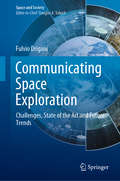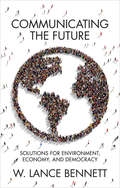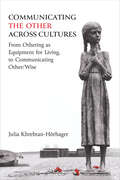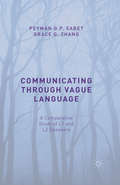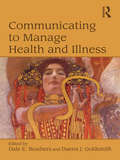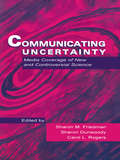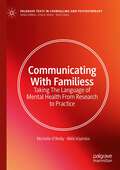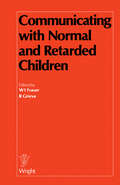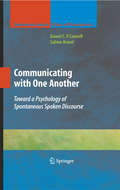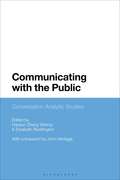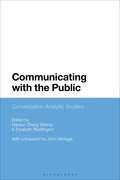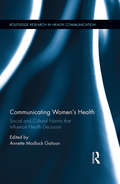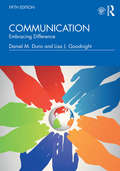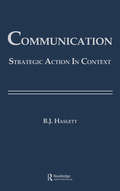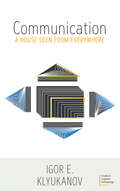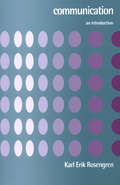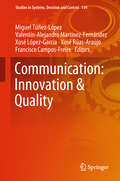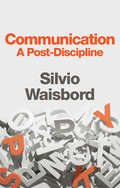- Table View
- List View
Communicating Space Exploration: Challenges, State of the Art and Future Trends (Space and Society)
by Fulvio DriganiThis book offers an enlightening analysis of the ways in which the communication of space explorations has evolved in response to political and social developments and the availability of new media and communication tools. Important challenges to effective communication are discussed, including the diversity of audiences, the risks associated with space missions, and continuing skepticism about the benefits of space research despite the many associated day-to-day applications. In addition, future trends in communication are examined with reference to likely trends in space exploration over the coming century. Besides space communication for the public, the need for targeted messaging to each group of stakeholders – decision makers, media, opinion leaders, the scientific community, and industry – is analyzed in detail. A series of case studies of particular space missions, both successful and unsuccessful, is presented to illustrate key issues. The book has significant implications for the communication of science in general and will be of interest to a wide audience, including space scientists, science communication professionals, people fascinated by exploration and discovery, stakeholders, and educators.
Communicating the Future: Solutions for Environment, Economy and Democracy
by W. Lance BennettWe are facing an unprecedented environmental crisis. How can we communicate and act more effectively to make the political and economic changes required to survive and even thrive within the life-support capacities of our planet? This is the question at the heart of W. Lance Bennett’s much-anticipated book. Bennett challenges readers to consider how best to approach the environmental crisis by changing how we think about the relationships between environment, economy, and democracy. He introduces a framework that citizens, practitioners, and scholars can use to evaluate common but unproductive communication that blocks thinking about change; develop more effective ways to define and approach problems; and design communication processes to engage diverse publics and organizations in developing understandings, goals, and political strategies. Until advocates develop economic programs with built-in environmental solutions, they will continue to lose policy fights. Putting “intersectional” communication into action requires acknowledging that communication is not only an exchange of messages, but an organizational process. Communicating the Future is important reading for students and scholars of media and communication, as well as general readers concerned about the environmental crisis.
Communicating the Future: Solutions for Environment, Economy and Democracy
by W. Lance BennettWe are facing an unprecedented environmental crisis. How can we communicate and act more effectively to make the political and economic changes required to survive and even thrive within the life-support capacities of our planet? This is the question at the heart of W. Lance Bennett’s much-anticipated book. Bennett challenges readers to consider how best to approach the environmental crisis by changing how we think about the relationships between environment, economy, and democracy. He introduces a framework that citizens, practitioners, and scholars can use to evaluate common but unproductive communication that blocks thinking about change; develop more effective ways to define and approach problems; and design communication processes to engage diverse publics and organizations in developing understandings, goals, and political strategies. Until advocates develop economic programs with built-in environmental solutions, they will continue to lose policy fights. Putting “intersectional” communication into action requires acknowledging that communication is not only an exchange of messages, but an organizational process. Communicating the Future is important reading for students and scholars of media and communication, as well as general readers concerned about the environmental crisis.
Communicating the Other across Cultures: From Othering as Equipment for Living, to Communicating Other/Wise
by Julia Khrebtan-HörhagerWhenever political and social decisions use categories of identity such as race, religion, social class, or nationality to distinguish groups of people, they risk holding certain groups as inferior and culturally “Other.” When people employ ideologies of imperialism, colonialism, patriarchy, and classism, they position certain groups as superior or ideal/ized people. Such ideological positioning causes nations to take actions that isolate or endanger minoritized populations. This cultural Othering can lead to atrocities such as Native Americans being expelled from their native lands through the Trail of Tears, millions of Ukrainians starving to death during the Holodomor, or millions of Jews exterminated during the Holocaust. Communicating the Other across Cultures uses examples from the United States, Western Europe, and Russia to demonstrate historical patterns of Othering people, as well as how marginalized people fight back against dominant powers that seek to silence or erase them. Deeply ingrained in our society, cultural Othering affects information in history books, children’s education, and the values upheld in our society. By taking a closer look at historical and modern instances of Othering, Julia Khrebtan-Hörhager shows examples of how different societies created ideas of social and cultural superiority or inferiority, and how deeply they are ingrained in our current society. In everyday life—the cash in your pocket, the movies shown at your local theater, museum exhibits, or politician's speeches—certain cultural ideologies are consistently upheld, while others are silenced. By exposing the communicative patterns of those in power, Khrebtan-Hörhager then suggests alternative ways of thinking, communicating, and eventually being, that offer transformative solutions for global problems.
Communicating through Vague Language: A Comparative Study of L1 and L2 Speakers
by Grace Q. Zhang Peyman G.P. SabetThis book is a comparative study of vague language based on naturally occurring data of L1 and L2 speakers in academic settings. It explores how L2 learners have diverse and culturally specific needs for vague language compared with L1s, and are generally vaguer.
Communicating to Manage Health and Illness
by Dale E. Brashers Daena GoldsmithCommunicating to Manage Health and Illness is a valuable resource for those in the field of health and interpersonal communication, public health, medicine, and related health disciplines. This scholarly edited volume advances the theoretical bases of health communication in two key areas: 1) communication, identity, and relationships; and 2) health care provider patient interaction. Chapters aim to underscore the theory that communication processes are a link between personal, social, cultural, and institutional factors and various facets of health and illness. Contributors to the work are respected scholars from the fields of communication, public health, medicine nursing, psychology, and other areas, and focus on ways in which patient identity is communicated in health-related interactions. This book serves as an excellent reference tool and is a substantial addition to health communication literature.
Communicating to Manage Health and Illness
by Dale E. Brashers Daena GoldsmithCommunicating to Manage Health and Illness is a valuable resource for those in the field of health and interpersonal communication, public health, medicine, and related health disciplines. This scholarly edited volume advances the theoretical bases of health communication in two key areas: 1) communication, identity, and relationships; and 2) health care provider patient interaction. Chapters aim to underscore the theory that communication processes are a link between personal, social, cultural, and institutional factors and various facets of health and illness. Contributors to the work are respected scholars from the fields of communication, public health, medicine nursing, psychology, and other areas, and focus on ways in which patient identity is communicated in health-related interactions. This book serves as an excellent reference tool and is a substantial addition to health communication literature.
Communicating Uncertainty: Media Coverage of New and Controversial Science
by Sharon M. Friedman Sharon Dunwoody Carol L. RogersExploring the interactions that swirl around scientific uncertainty and its coverage by the mass media, this volume breaks new ground by looking at these issues from three different perspectives: that of communication scholars who have studied uncertainty in a number of ways; that of science journalists who have covered these issues; and that of scientists who have been actively involved in researching uncertain science and talking to reporters about it. In particular, Communicating Uncertainty examines how well the mass media convey to the public the complexities, ambiguities, and controversies that are part of scientific uncertainty. In addition to its new approach to scientific uncertainty and mass media interactions, this book distinguishes itself in the quality of work it assembles by some of the best known science communication scholars in the world. This volume continues the exploration of interactions between scientists and journalists that the three coeditors first documented in their highly successful volume, Scientists and Journalists: Reporting Science as News, which was used for many years as a text in science journalism courses around the world.
Communicating Uncertainty: Media Coverage of New and Controversial Science
by Sharon M. Friedman Sharon Dunwoody Carol L. RogersExploring the interactions that swirl around scientific uncertainty and its coverage by the mass media, this volume breaks new ground by looking at these issues from three different perspectives: that of communication scholars who have studied uncertainty in a number of ways; that of science journalists who have covered these issues; and that of scientists who have been actively involved in researching uncertain science and talking to reporters about it. In particular, Communicating Uncertainty examines how well the mass media convey to the public the complexities, ambiguities, and controversies that are part of scientific uncertainty. In addition to its new approach to scientific uncertainty and mass media interactions, this book distinguishes itself in the quality of work it assembles by some of the best known science communication scholars in the world. This volume continues the exploration of interactions between scientists and journalists that the three coeditors first documented in their highly successful volume, Scientists and Journalists: Reporting Science as News, which was used for many years as a text in science journalism courses around the world.
Communicating With Families: Taking The Language of Mental Health From Research to Practice (Palgrave Texts in Counselling and Psychotherapy)
by Michelle O'Reilly Nikki KiyimbaThis textbook uniquely highlights the particular complexities of working systemically with couples and families with children. It is designed to be student and practitioner oriented by drawing on real world examples of therapeutic encounters in mental health settings to illustrate how theory can inform practice. Good communication is the cornerstone of good clinical practice and is foundational for building therapeutic alliance. Although therapists and counsellors are often highly skilled in their therapeutic modalities, this book offers additional practical suggestions about how families engage in social actions and positioning themselves and others in their talk. The book also takes wider micro and macro ecological systems within which systemic psychotherapists and counsellors work into account and consider the ways that these larger social influences are experienced within institutional discourses. The book will be a valuable resource across a broad spectrum of professions and researchers, including counsellors, psychotherapists, family therapists, psychiatrists, nurses, play therapists, speech and language therapists, and mental health social workers.
Communicating with Normal and Retarded Children
by W. I. Fraser R. GrieveCommunicating with Normal and Retarded Children explores the way in which normal children acquire language and the mistakes they make. It aims to trace the common growth between professions in understanding of normal language development and the retarded person's language and to encourage research, particularly of an interdisciplinary kind. This book is organized into five main sections. The contributors provide different professional perspectives of how and why the mentally retarded get their communication wrong and what remedies can be applied. They also present their own research findings, often in little-explored areas or from a novel angle, and offer their opinion on the types and topics of research that should be carried out. This book will be of interest to academic and clinical psychologists, educators, linguists, advisors and tutors in nursing and social studies, child health doctors, psychiatrists, and a range of therapists.
Communicating with One Another: Toward a Psychology of Spontaneous Spoken Discourse (Cognition and Language: A Series in Psycholinguistics)
by Sabine KowalIn contrast to traditional approaches of mainstream psycholinguists, the authors of Communicating with One Another approach spontaneous spoken discourse as a dynamic process, rich with structures, patterns, and rules other than conventional grammar and syntax. Daniel C. O’Connell and Sabine Kowal thoroughly critique mainstream psycholinguistics, proposing instead a shift in theoretical focus from experimentation to field observation, from monologue to dialogue, and from the written to the spoken. They invoke four theoretical principles: intersubjectivity, perspectivity, open-endedness, and verbal integrity. Their analyses of historical and original research raise significant questions about the relationship between spoken and written discourse, particularly with regard to transcription and punctuation. With emphasis on political discourse, media interviews, and dramatic performance, the authors review both familiar and unexplored characteristics of spontaneous spoken communication, including: (1) The speaker’s use of prosody. (2) The functions of interjections. (3) What fillers do for a living. (4) Turn-taking: Smooth and otherwise. (5) Laughter, applause, and booing: from individual listener to collective audience. (6) Pauses, silence, and the art of listening. The paradigm shift proposed in Communicating with One Another will interest and provoke readers concerned about communicative language use – including psycholinguists, sociolinguists, and anthropological linguists.
Communicating with the Public: Conversation Analytic Studies
by Hansun Zhang Waring and Elizabeth ReddingtonThis book offers a collection of conversation analytic investigations into how one US-based philanthropic organization communicates its mission of improving public health. In contrast to political speeches or news interviews with prominent figures, much communication with the public involves the routine work undertaken by institutional representatives as they interact with external audiences: this book considers precisely how this work is accomplished.Communicating with the Public broadens the scope of conversation analysis by unveiling the interactive, multi-party, and multi-modal nature of institutional messaging that might otherwise be construed as a scripted, monologic undertaking. To this end, it examines a diverse array of contemporary platforms, including webinars, podcasts, and television interviews, as well as face-to-face conversations following public talks and panel discussions. Chapters reveal how both foundation representatives and their interlocutors target messaging to specific audiences that may or may not be present, manage the logistics of delivering this messaging, and position themselves as credible experts or a unified institutional collective.
Communicating with the Public: Conversation Analytic Studies
This book offers a collection of conversation analytic investigations into how one US-based philanthropic organization communicates its mission of improving public health. In contrast to political speeches or news interviews with prominent figures, much communication with the public involves the routine work undertaken by institutional representatives as they interact with external audiences: this book considers precisely how this work is accomplished.Communicating with the Public broadens the scope of conversation analysis by unveiling the interactive, multi-party, and multi-modal nature of institutional messaging that might otherwise be construed as a scripted, monologic undertaking. To this end, it examines a diverse array of contemporary platforms, including webinars, podcasts, and television interviews, as well as face-to-face conversations following public talks and panel discussions. Chapters reveal how both foundation representatives and their interlocutors target messaging to specific audiences that may or may not be present, manage the logistics of delivering this messaging, and position themselves as credible experts or a unified institutional collective.
Communicating Women's Health: Social and Cultural Norms that Influence Health Decisions (Routledge Research in Health Communication)
by Annette Madlock GatisonThis volume explores the conditions under which women are empowered, and feel entitled, to make the health decisions that are best for them. At its core, it illuminates how the most basic element of communication, voice, has been summarily suppressed for entire groups of women when it comes to control of their own sexuality, reproductive lives, and health. By giving voice to these women’s experiences, the book shines a light on ways to improve health communication for women. Bringing together personal narratives, key theory and literature, and original qualitative and quantitative studies, the book provides an in-depth comparative picture of how and why women’s health varies for distinct groups of women. Organized into four parts—historical influences on patient and provider perceptions, breast cancer the silence and the shame, make it taboo: mothering, reproduction, and womanhood, and sex, sexuality, relational health, and womanhood—each section is introduced with a brief synthesis and discussion of the key questions addressed across the chapters.
Communicating Women's Health: Social and Cultural Norms that Influence Health Decisions (Routledge Research in Health Communication)
by Annette Madlock GatisonThis volume explores the conditions under which women are empowered, and feel entitled, to make the health decisions that are best for them. At its core, it illuminates how the most basic element of communication, voice, has been summarily suppressed for entire groups of women when it comes to control of their own sexuality, reproductive lives, and health. By giving voice to these women’s experiences, the book shines a light on ways to improve health communication for women. Bringing together personal narratives, key theory and literature, and original qualitative and quantitative studies, the book provides an in-depth comparative picture of how and why women’s health varies for distinct groups of women. Organized into four parts—historical influences on patient and provider perceptions, breast cancer the silence and the shame, make it taboo: mothering, reproduction, and womanhood, and sex, sexuality, relational health, and womanhood—each section is introduced with a brief synthesis and discussion of the key questions addressed across the chapters.
Communication: Embracing Difference
by Daniel M Dunn Lisa J GoodnightCommunication: Embracing Difference, 5e, provides the fundamentals of communication theory in accessible terms and emphasizes the practical application of communication skills in interpersonal, small group, and public settings, which helps students become more confident and successful communicators. Designed for the hybrid class, this new edition offers an enhanced dual intercultural and career-based approach; new examples and breakout boxes throughout draw connections to communicating in the workplace, experiential learning, and communicating in a global society. Offering a foundation that readers can take beyond the classroom, this volume is designed to resonate with the diverse student populations that make up so many campuses today.
Communication: Embracing Difference
by Daniel M Dunn Lisa J GoodnightCommunication: Embracing Difference, 5e, provides the fundamentals of communication theory in accessible terms and emphasizes the practical application of communication skills in interpersonal, small group, and public settings, which helps students become more confident and successful communicators. Designed for the hybrid class, this new edition offers an enhanced dual intercultural and career-based approach; new examples and breakout boxes throughout draw connections to communicating in the workplace, experiential learning, and communicating in a global society. Offering a foundation that readers can take beyond the classroom, this volume is designed to resonate with the diverse student populations that make up so many campuses today.
Communication: Strategic Action in Context (Routledge Communication Series)
by Beth Bonniwell HaslettFirst Published in 1987. Routledge is an imprint of Taylor & Francis, an informa company.
Communication: Strategic Action in Context (Routledge Communication Series)
by Beth Bonniwell HaslettFirst Published in 1987. Routledge is an imprint of Taylor & Francis, an informa company.
Communication: A House Seen from Everywhere (Studies in Linguistic Anthropology #2)
by Igor E. KlyukanovFocusing on the scientific study of communication, this book is a systematic examination. To that end, the natural, social, cultural, and rational scientific perspectives on communication are presented and then brought together in one unifying framework of the semiotic square, showing how all four views are interconnected. The question of whether the study of communication can be considered a unique science is addressed. It is argued that communication is never separate from any object of study and thus we always deal with its manifestations, captured in the four scientific perspectives discussed in the book.
Communication: An Introduction
by Karl Erik RosengrenWritten as an introduction for beginning students, this book offers a thorough, yet lively, overview of human communication in all its aspects. Accessibly written and assuming no prior knowledge of the discipline Communication: An Introduction: offers a thorough, yet lively, examination of all aspects of human communication, including: a summary of its nature, form and function; a detailed analysis of all the levels of communication; a description and overview of the different traditions of communication studies; and a consideration of the future of communication - as a phenomenon and as a field of research.
Communication: An Introduction (PDF)
by Karl Erik RosengrenWritten as an introduction for beginning students, this book offers a thorough, yet lively, overview of human communication in all its aspects. Accessibly written and assuming no prior knowledge of the discipline Communication: An Introduction: offers a thorough, yet lively, examination of all aspects of human communication, including: a summary of its nature, form and function; a detailed analysis of all the levels of communication; a description and overview of the different traditions of communication studies; and a consideration of the future of communication - as a phenomenon and as a field of research.
Communication: Innovation & Quality (Studies in Systems, Decision and Control #154)
by Miguel Túñez-López Valentín-Alejandro Martínez-Fernández Xosé López-García Xosé Rúas-Araújo Francisco Campos-FreireThis book explores the disruptive changes in the media ecosystem caused by convergence and digitization, and analyses innovation processes in content production, distribution and commercialisation. It has been edited by Professors Miguel Túñez-López (Universidade de Santiago de Compostela, Spain), Valentín-Alejandro Martínez-Fernández (Universidade da Coruña, Spain), Xosé López-García (Universidade de Santiago de Compostela, Spain), Xosé Rúas-Araújo (Universidade de Vigo, Spain) and Francisco Campos-Freire (Universidade de Santiago de Compostela, Spain). The book includes contributions from European and American experts, who offer their views on the audiovisual sector, journalism and cyberjournalism, corporate and institutional communication, and education. It particularly highlights the role of new technologies, the Internet and social media, including the ethics and legal dimensions. With 30 contributions, grouped into diverse chapters, on information preferences and uses in journalism, as well as public audiovisual policies in the European Union, related to governance, funding, accountability, innovation, quality and public service, it provides a reliable media resource and presents lines of future development.
Communication: A Post-Discipline (Handbooks In Communication And Media Ser. #29)
by Silvio WaisbordCommunication studies is a fragmented field. As a result of its roots in various disciplinary traditions, it is built on fluid intellectual boundaries with no theoretical or analytical center. Should we worry about this state of dispersion or be concerned that the discipline does not meet the basic conditions that define an academic field of inquiry? Silvio Waisbord argues that communication studies is a post-discipline and that it is impossible to transcend fragmentation and specialization through a single project of intellectual unity. What brings communication studies together is an institutional architecture of academic units, professional associations, and journals, rather than a shared commitment to a common body of knowledge, questions, and debates. This should not, Waisbord argues, be a matter of concern. Communication studies is better served by recognizing dispersion, embracing pluralism, fostering cross-cutting lines of inquiry, and tackling real-world problems, rather than hoping to meet conditions which would qualify it as a discipline. Communication: A Post-Discipline is important reading for scholars and advanced students of communication studies, as well as anyone interested in the state of this fascinating and vital academic field.
